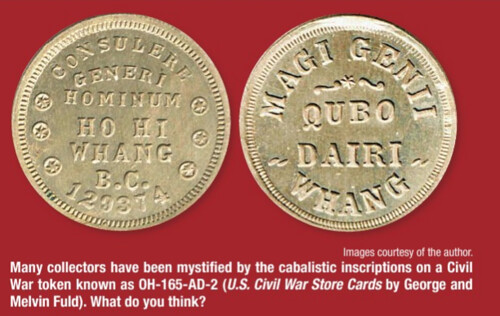
PREV ARTICLE
NEXT ARTICLE
FULL ISSUE
PREV FULL ISSUE
AN INTRIGUING U.S. CIVIL WAR TOKEN: OH-165-AD-2
In his Joys of Collecting column in the October 8, 2012 issue of CoinWorld, Dave Bowers discusses an intriguing U.S. Civil War Token. At my request he kindly forwarded me the text of the article - here's a lengthy excerpt. Thanks!
-Editor

I love a mystery! And, numismatics has more mysteries than anyone can easily count. Among these is a Civil War token issued by the Cincinnati shop of John Stanton. The token described by George and Melvin Fuld in U.S. Civil War Store Cards as variety OH-165-AD-2 has been a puzzle to many collectors for a long time. The words have no obvious connection with each other, but most are pronounceable—not random letters. The obverse includes CONSULERE / GENERI / HOMINUM / HO HI / WHANG / B.C. / 129374. The reverse is lettered MAGI GENII / QUBO DAIRI / WHANG. The Fulds considered them to be magicians’ tokens. It has also been suggested that these were practice pieces for apprentice die sinkers in the Stanton shop. Trying to learn more I started browsing around in my library: In the sale of the C.W. Idell Collection, Bangs & Co., New York, January 8 and 9, 1878, cataloger E.J. Attinelli described under Lot 624 the lettering of this token and stated that the token was “a poke at coin collectors.” Similarly, in The Numismatist, December 1899, Benjamin P. Wright in his “American Store or Business Cards” stated it was “a satirical issue directed against coin collectors.” The words may be mostly nonsense, although consuleri, generi, and hominem (sic) are were widely used in Latin texts. Dairi describes a bronze image of Buddha. Magi and genii have connotations of magic, perhaps inspiring the comment by the Fulds. B.C. may relate to the dating of certain ancient coins. Whang appears in many contexts in the 1860s and earlier, ranging from a proper name to a large quantity of anything such as a whang of cheese or coal. Perhaps in the 1860s a “whang” of 129,374 tokens was imagined. For me the mystery is solved: a satire on collectors as stated years ago, but seemingly forgotten in the meantime.
Neat item. Gotta love a good mystery. Dave's conclusion is as good as any. I'm willing to accept Attinelli's explanation - we've had little cause to doubt his other writings. Can anyone add to the discussion? Do these words mean anything in another context, or are the completely nonsense?
-Editor
Wayne Homren, Editor The Numismatic Bibliomania Society is a non-profit organization promoting numismatic literature. See our web site at coinbooks.org. To submit items for publication in The E-Sylum, write to the Editor at this address: whomren@gmail.com To subscribe go to: https://my.binhost.com/lists/listinfo/esylum All Rights Reserved. NBS Home Page Contact the NBS webmaster 
|